![]()
![]()
![]()
Use LEFT and RIGHT arrow keys to navigate between flashcards;
Use UP and DOWN arrow keys to flip the card;
H to show hint;
A reads text to speech;
10 Cards in this Set
- Front
- Back

White Temple of Uruk |
Iraq
Sumerian 3500 BCE - mud brick Artist:Trades People Patron: Rulers of Sumer Context: - Sumerian’s were ruled by their God’s. Each city had a patron God who looked over the people and ruled through the High Priest. - All facets of society were to be presented for the God’s judgment – including harvest, trade and war. - People lived in fear of displeasing the God Function: RELIGION/POLITICAL/ECONOMY: - Where the sky god, Anu, would make his judgments. - Their deity would descend from the sky into the cella through an open roof and communicate with the priests. - All revenue, including crops and trade would be presented to the deity in the cella, where the leaders and priests would take careful record of the city’s wealth. VA: - Located in center of city; reminds people of who they serve. - Highest structure in the city; establishing power and authority of the god - Each corner is oriented to the cardinal points of the compass- signifying spiritual alignment with the cosmos - Bent Axis plan: no direct, frontal stairs; no common worshipers only priests and leaders |
|
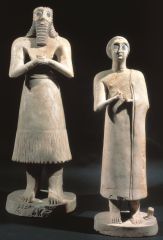
Sumerian Votive Offerings |
Modern day Iraq Sumerian 2,700 BCE - Gypsum inlaid with shell and black limestone - Mortal Sumerian worshipers of all sizes Context: - Because of war and disease Sumerians lived in fear of Gods, and believe constant prayer is needed to ensure their protection from the horrible afterlife that awaits them Function: RELIGIOUS, Commissioned by worshipers for specific gods. - Sumerian had to work daily they could not pray to the God’s all day. Thus these statues each represent a Sumerian citizen. - They are a substitute for worshiper, offering constant prayer, awe and reverence to the God to ensure a long life. They would be placed in temples facing altars or statues of Gods. VA: - size depends on wealth and importance of patron - bodies simple and focuses on prayer not themselves. - They clasp their hands to demonstrate reverence for the God. - eyes are large and wide to demonstrate the worshiper awe for the God. |
|
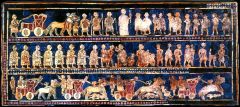
Standard of Ur |
Sumerian 3,000 BCE- Panel inlayed with lapis lazuli and red limestone - Regal families buried their dead in vaulted chambers - included golf helmets, daggers, jewelry, servants, soldiers, and musicians (to bring to the afterlife, people were sacrificed to accompany them) - Two sides of Sumerian life: War & Peace; establishes role of a successful leader - historical narrative (?) - 3 registers each side, tells a story; bottom to top WAR: 1. Defeated being trampled 2. Gathering and leading conquered enemies- conquered in the nude; no dignity 3. delivering conquered to king who surveys them in the middle with army behind him. PEACE: 1. Gathering of crops 2. Delivery of crops and animals 3. King presides over peaceful banquet - Hierarchical scale: the leader is largest and central – signifying his power and authority - Twisted perspective - Meaning: Expresses the idea that the Sumerian King has two principle roles: Mighty warrior and chief administrator who, with the blessing of the Gods, assures the prosperity of the land during peace |
|
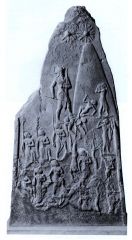
Stele of Naram-Sin |
Akkadian 2,250 BCE carved sand-stone relief Stele - an upright stone slab or column typically bearing a commemorative inscription or relief design, often serving as a gravestone Content: King Naram-Sin leading his army up a mountain to victory. Context: - The Akkadian Empire conquered the Sumer City States through brute force. - The Akkadians were fierce warriors lead by warrior-kings. - Unlike the Sumerian’s theirs was a Monarchy. The King was the ultimate ruler, was blessed by the Gods, and was himself likened to a God Function: POLITICAL/HISTORICAL - To commemorate the victory of Naram-Sin, and establish his Godlikeauthority VA: - tells a story in a single landscape. Read bottom to top - BOTTOM: army of Naram-Sin; calm and orderly, while the enemy is in disarray – symbolizing Naram-Sin’s successful rule - Naram-Sin stands alone at the top of the the mountain in triumph. His stance is confident and he is larger then the rest – signifies his status as a king-god - steps on the bodies of those he has defeated - wears a horned helmet signifying divinity gained through victory. Above him are two suns – they represent Gods. Here Naram is rising into the heavens – he is closest to the Gods who shine their light on him in approval |
|
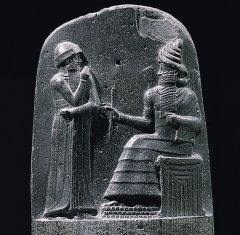
Law Code of Hammurabi Stele |
bv |
|
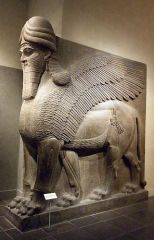
Lamassu |
|
|

Assyrian Archer Pursuing the Enemies |
|
|
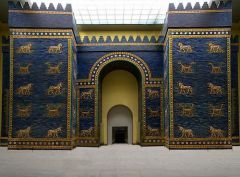
Gates of Ishtar |
|
|
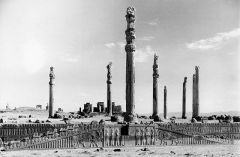
Audience Hall of Darius and Xerxes |
|
|

Persians and Medes |
|

